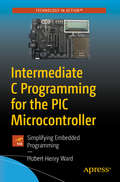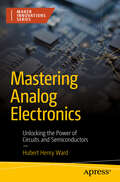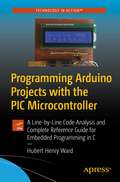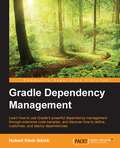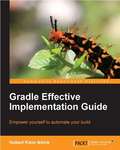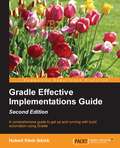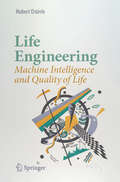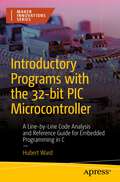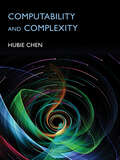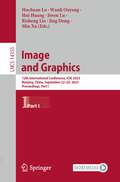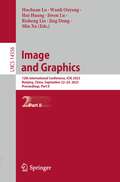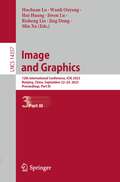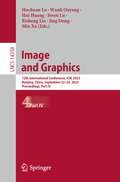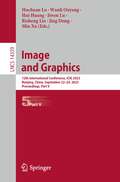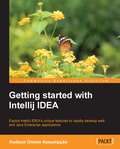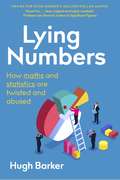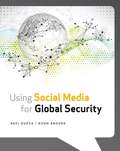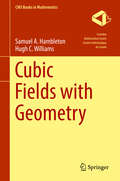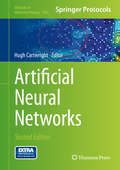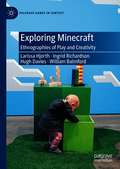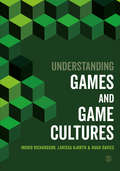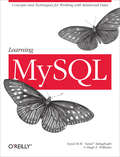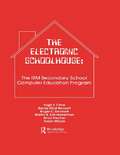- Table View
- List View
Intermediate C Programming for the PIC Microcontroller: Simplifying Embedded Programming
by Hubert Henry WardDelve into the exciting world of embedded programming with PIC microcontrollers in C. The key to learning how to program is to understand how the code works – and that is what you’ll learn here. Following C Programming for the PIC Microcontroller, this book continues exploring the coding required to control the PIC microcontroller and can be used as a standalone single reference, or paired with the previous title to enhance your programming skills. You'll see how to control the position of a servo motor and use the compare aspect of the CCP module to create a square wave with varying frequency. You'll also work with the capture aspect of the CCP to determine the frequency of a signal inputted to the PIC and use external and internal interrupts.This book breaks down the programs with line-by-line analysis to give you a deep understanding of the code. After reading it you’ll be able to use all three aspects of the Capture, Compare and PWM module; work with different types of interrupts; create useful projects with the 7 segment display; and use the LCD and push button keyboard. What You’ll LearnCreate a small musical keyboard with the PICManage a stepper motor with the PICUse the main features of the MPLABX IDEInterface the PIC to the real worldDesign and create useful programs based around the PIC18F4525 Who This Book Is ForEngineering students and hobbyist who want to try their hand at embedded programming the PIC micros.
Mastering Analog Electronics: Unlocking the Power of Circuits and Semiconductors (Maker Innovations Series)
by Hubert Henry WardEmbark on a transformative journey through the intricate world of analogue electronics. This comprehensive guide is designed to empower learners at every level with the knowledge and practical expertise necessary for a successful career in analogue electronics. Starting with the foundational disparities between analogue and digital electronics, this book provides a clear understanding of current flow, conductors, and insulators. You’ll delve into the realm of semiconductors, uncovering their revolutionary impact and the art of manipulating them through doping techniques. The heart of analogue circuitry comes alive as you explore PN junctions, grasp diode behavior, and utilize TINA 12 ECAD software for hands-on simulations. Transistors and the Opamp then take center-stage, from their configurations to their roles as switches and amplifiers, with practical examples and simulations enhancing your comprehension. Master the unique attributes of bipolar junction transistors and field effect transistors, honing your skills using TINA 12. Dive into operational amplifiers functions, and versatile configurations, and navigate mathematical operations and signal filtering. Whether you're a novice or an experienced engineer, embark on this educational journey today with Mastering Analogue Electronics and unleash your potential in analogue circuit design. What You’ll Learn Understand the dynamics of current flow. Explore semiconductor structures and their role in crafting diodes and transistors. Dive into the world of Uni Junction Transistors and Field Effect Transistors. Design a spectrum of analogue circuits, unleashing your creative potential. Harness the potential of oscillators such as the multivibrator, the 555 timer and the Wien Bridge oscillator. Gain an introduction to the basic low and high pass filters both passive and active. Who This Book Is For This book is tailored for students pursuing engineering qualifications, hobbyists keen on designing analogue circuits, engineers seeking a comprehensive reference on analogue electronics, teachers, and students in need of a valuable teaching resource.
Programming Arduino Projects with the PIC Microcontroller: A Line-by-Line Code Analysis and Complete Reference Guide for Embedded Programming in C
by Hubert Henry WardNow that you’ve built a few Arduino projects, and reused some pre-written sketches, it’s time to move on to the next step and explore the world of embedded programming. To truly up-skill, you'll need to understand how your code works, and that's where this book comes in. You'll review and work with several Arduino projects plus two extra ones written for a PIC microcontroller. Each one is accompanied with a basic circuit diagram and photos of the program working. Ideal for the Arduino hobbyist and PIC programmers who want to merge their skills, this comprehensive book will go over every aspect of the 8-bit microcontroller, provide line-by-line analysis of the code, and in the end, show you how to bring your Arduino projects to the PIC microcontroller using C. You'll gain a full understanding of how the C instructions work and can be used with the PIC microcontroller.Programming Arduino Projects with the PIC Microcontroller is your one-stop reference resource. What You’ll LearnExamine how the code works Create code to perform any functionBuild practical projects on vero boards with full vero plans and circuit diagramsUnderstand how programs work by simulation with an ECAD package Who This Book Is ForWould-be embedded programmers, Arduino hobbyists, and PIC programmers.
Gradle Dependency Management
by Hubert Klein IkkinkIf you work on Java projects, use Gradle as a build automation tool, and you use dependencies in your project, this is the book for you. Additionally, if you want to deploy your project artifacts as dependencies for other developers using Gradle, you've found the right book.
Gradle Effective Implementation Guide
by Hubert Klein IkkinkWritten in Packt's tutorial format the hands on examples and real life applications that will guide you through Gradle and give you the knowledge to use it every day. If you are a Java developer who wants to automate compiling, packaging and deploying your application this book is for you.
Gradle Effective Implementations Guide - Second Edition
by Hubert Klein IkkinkA comprehensive guide to get up and running with build automation using Gradle About This Book * Practical and engaging from start to finish covering the fundamentals of Gradle * Learn the skills required to develop Java applications with Gradle and integrate at an enterprise level * Apply the correct plugin and configuration to our Gradle build files to work with the different languages Who This Book Is For This book is for Java developers who have working knowledge of build automation processes and are now looking to gain expertise with Gradle and add to their skill set. What You Will Learn * Write your first Gradle Script * Write build logic with the Gradle build language * Explore the Java plugins supported by Gradle * Understand dependency management in Gradle * Package and publish your (web) application * Integrate Scala and Groovy with Gradle * Write your own custom tasks and plugins * Integrate Gradle with your IDE In Detail Gradle is a project automation tool that has a wide range of applications. The basic aim of Gradle is to automate a wide variety of tasks performed by software developers, including compiling computer source code to binary code, packaging binary codes, running tests, deploying applications to production systems, and creating documentation. The book will start with the fundamentals of Gradle and introduce you to the tools that will be used in further chapters. You will learn to create and work with Gradle scripts and then see how to use Gradle to build your Java Projects. While building Java application, you will find out about other important topics such as dependency management, publishing artifacts, and integrating the application with other JVM languages such as Scala and Groovy. By the end of this book, you will be able to use Gradle in your daily development. Writing tasks, applying plugins, and creating build logic will be your second nature. Style and approach This step-by-step guide aims to cover the fundamentals of Gradle and focuses on providing the practical skills required to develop web application.
PowerPoint, Communication, and the Knowledge Society
by Hubert KnoblauchPowerPoint has become an integral part of academic and professional life across the globe. In this book, Hubert Knoblauch offers the first complete analysis of the PowerPoint presentation as a form of communication. Knoblauch charts the diffusion of PowerPoint and explores its significance as a ubiquitous and influential element of contemporary communication culture. His analysis considers the social and intellectual implications of the genre, focusing on the dynamic relationships between the aural, visual and physical dimensions of PowerPoint presentations, as well as the diverse institutional contexts in which these presentations take place. Ultimately, Knoblauch argues that the parameters of the PowerPoint genre frames the ways in which information is presented, validated and absorbed, with ambiguous consequences for the acquisition and transmission of knowledge. This original and timely book is relevant to scholars of communications, sociology and education.
Life Engineering: Machine Intelligence and Quality of Life
by Hubert OsterleMachine Intelligence is changing every aspect of our lives. Internet traffic and sensors in households, cars, and wearables provide data that oligopolistic companies collect and use to extract patterns of human behavior. Further, active digital assistants are taking over more and more of our everyday decisions. Humanity is on the verge of an evolutionary leap and it is time to determine if this development will benefit people’s wellbeing or will just mean the accumulation of capital and power with no regard for quality of life. This book integrates the perspectives of various disciplines that are striving to establish resilient foundations – computer science, economics and social sciences, political science, psychology, philosophy, neuroscience, ethics and religion – in order to clarify a number of positions and, as a result, objectify the discussions. Written by Hubert Osterle, a researcher working at the interface of these disciplines, the book promotes debate on the future of man and machine, on happiness and evolution and on the major changes brought about by digital technology. Last but not least, it is a manifesto calling for a new – integrated – discipline to be founded: life engineering.
Introductory Programs with the 32-bit PIC Microcontroller: A Line-by-Line Code Analysis and Reference Guide for Embedded Programming in C
by Hubert WardEmbark on a journey into the world of embedded programming. This book introduces you to the 32bit PIC and will teach you how the main functions of C programming work and can be used with a PIC micro.A one-stop reference for the would-be embedded programmer, you'll explore the electronics needed for a variety of programs as well as how to use different devices with the PIC. The book starts with downloading the environment and creating a simple project, one that uses different oscillators, Phase Lock Loop, and circuitry needed to create the different system clocks—an easy entry point to this exciting environment. You'll also review the MPLABX integrated development environment (IDE) and see how to program the 32Bit PIC, which can be adapted to different PICs. Throughout subsequent chapters, you’ll learn how to use a range of programs that use PIC modules such as the SPI, I2C, UART communication modules, the ADC module, the Capture, Compare, and Pulse Width Modulation module, and the RTCC, Real Time Clock and Calendar Module. What You'll Learn Create a project in MPLABX Configure the different clock frequencies that are used in the 32bit PICBuild a variable delay subroutine to be used in a simple traffic lights programUse the MAX 7219 driver IC to control the 8by8 matrix displayProgram an I2C expander module to control the display on a LCD Who This Book Is For Readers who want to try their hand at embedded programming, newcomers to programming the PIC 32, programmers who want to look into using MPLAB Harmony 3, and programmers who want to understand how C instructions work with respect to 32bit PIC. Also students who are studying for an engineering qualification.
Computability and Complexity
by Hubie ChenA clear, comprehensive, and rigorous introduction to the theory of computation.What is computable? What leads to efficiency in computation? Computability and Complexity offers a clear, comprehensive, and rigorous introduction to the mathematical study of the capabilities and limitations of computation. Hubie Chen covers the core notions, techniques, methods, and questions of the theory of computation before turning to several advanced topics. Emphasizing intuitive learning and conceptual discussion, this textbook&’s accessible approach offers a robust foundation for understanding both the reach and restrictions of algorithms and computers.Extensive exercises and diagrams enhance streamlined, student-friendly presentation of mathematically rigorous materialIncludes thorough treatment of automata theory, computability theory, and complexity theory—including the P versus NP question and the theory of NP-completenessSuitable for undergraduate and graduate students, researchers, and professionals
Image and Graphics: 12th International Conference, ICIG 2023, Nanjing, China, September 22–24, 2023, Proceedings, Part I (Lecture Notes in Computer Science #14355)
by Min Xu Hui Huang Jiwen Lu Huchuan Lu Jing Dong Wanli Ouyang Risheng LiuThe five-volume set LNCS 14355, 14356, 14357, 14358 and 14359 constitutes the refereed proceedings of the 12th International Conference on Image and Graphics, ICIG 2023, held in Nanjing, China, during September 22–24, 2023.The 166 papers presented in the proceedings set were carefully reviewed and selected from 409 submissions. They were organized in topical sections as follows: computer vision and pattern recognition; computer graphics and visualization; compression, transmission, retrieval; artificial intelligence; biological and medical image processing; color and multispectral processing; computational imaging; multi-view and stereoscopic processing; multimedia security; surveillance and remote sensing, and virtual reality.The ICIG 2023 is a biennial conference that focuses on innovative technologies of image, video and graphics processing and fostering innovation, entrepreneurship, and networking. It will feature world-class plenary speakers, exhibits, and high-quality peer reviewed oral and poster presentations.
Image and Graphics: 12th International Conference, ICIG 2023, Nanjing, China, September 22–24, 2023, Proceedings, Part II (Lecture Notes in Computer Science #14356)
by Min Xu Hui Huang Jiwen Lu Huchuan Lu Jing Dong Wanli Ouyang Risheng LiuThe five-volume set LNCS 14355, 14356, 14357, 14358 and 14359 constitutes the refereed proceedings of the 12th International Conference on Image and Graphics, ICIG 2023, held in Nanjing, China, during September 22–24, 2023.The 166 papers presented in the proceedings set were carefully reviewed and selected from 409 submissions. They were organized in topical sections as follows: computer vision and pattern recognition; computer graphics and visualization; compression, transmission, retrieval; artificial intelligence; biological and medical image processing; color and multispectral processing; computational imaging; multi-view and stereoscopic processing; multimedia security; surveillance and remote sensing, and virtual reality.The ICIG 2023 is a biennial conference that focuses on innovative technologies of image, video and graphics processing and fostering innovation, entrepreneurship, and networking. It will feature world-class plenary speakers, exhibits, and high quality peer reviewed oral and poster presentations.
Image and Graphics: 12th International Conference, ICIG 2023, Nanjing, China, September 22–24, 2023, Proceedings, Part III (Lecture Notes in Computer Science #14357)
by Min Xu Hui Huang Jiwen Lu Huchuan Lu Jing Dong Wanli Ouyang Risheng LiuThe five-volume set LNCS 14355, 14356, 14357, 14358 and 14359 constitutes the refereed proceedings of the 12th International Conference on Image and Graphics, ICIG 2023, held in Nanjing, China, during September 22–24, 2023.The 166 papers presented in the proceedings set were carefully reviewed and selected from 409 submissions. They were organized in topical sections as follows: computer vision and pattern recognition; computer graphics and visualization; compression, transmission, retrieval; artificial intelligence; biological and medical image processing; color and multispectral processing; computational imaging; multi-view and stereoscopic processing; multimedia security; surveillance and remote sensing, and virtual reality.The ICIG 2023 is a biennial conference that focuses on innovative technologies of image, video and graphics processing and fostering innovation, entrepreneurship, and networking. It will feature world-class plenary speakers, exhibits, and high-quality peer reviewed oral and poster presentations.
Image and Graphics: 12th International Conference, ICIG 2023, Nanjing, China, September 22–24, 2023, Proceedings, Part IV (Lecture Notes in Computer Science #14358)
by Min Xu Hui Huang Jiwen Lu Huchuan Lu Jing Dong Wanli Ouyang Risheng LiuThe five-volume set LNCS 14355, 14356, 14357, 14358 and 14359 constitutes the refereed proceedings of the 12th International Conference on Image and Graphics, ICIG 2023, held in Nanjing, China, during September 22–24, 2023.The 166 papers presented in the proceedings set were carefully reviewed and selected from 409 submissions. They were organized in topical sections as follows: computer vision and pattern recognition; computer graphics and visualization; compression, transmission, retrieval; artificial intelligence; biological and medical image processing; color and multispectral processing; computational imaging; multi-view and stereoscopic processing; multimedia security; surveillance and remote sensing, and virtual reality.The ICIG 2023 is a biennial conference that focuses on innovative technologies of image, video and graphics processing and fostering innovation, entrepreneurship, and networking. It will feature world-class plenary speakers, exhibits, and high-quality peer reviewed oral and poster presentations.
Image and Graphics: 12th International Conference, ICIG 2023, Nanjing, China, September 22–24, 2023, Proceedings, Part V (Lecture Notes in Computer Science #14359)
by Min Xu Hui Huang Jiwen Lu Huchuan Lu Jing Dong Wanli Ouyang Risheng LiuThe five-volume set LNCS 14355, 14356, 14357, 14358 and 14359 constitutes the refereed proceedings of the 12th International Conference on Image and Graphics, ICIG 2023, held in Nanjing, China, during September 22–24, 2023.The 166 papers presented in the proceedings set were carefully reviewed and selected from 409 submissions. They were organized in topical sections as follows: computer vision and pattern recognition; computer graphics and visualization; compression, transmission, retrieval; artificial intelligence; biological and medical image processing; color and multispectral processing; computational imaging; multi-view and stereoscopic processing; multimedia security; surveillance and remote sensing, and virtual reality.The ICIG 2023 is a biennial conference that focuses on innovative technologies of image, video and graphics processing and fostering innovation, entrepreneurship, and networking. It will feature world-class plenary speakers, exhibits, and high-quality peer reviewed oral and poster presentations.
Getting started with IntelliJ IDEA
by Hudson Orsine AssumpcaoA practical, fast-paced guide with clear, step-by-step exercisesto help you understand the basics of IntelliJ Idea and develop a web application.This book will be ideal if you are a Java developer who has a little knowledge about IntelliJ and wants to get more information on using it to improve your development performance.
Lying Numbers: How Maths and Statistics Are Twisted and Abused
by Hugh BarkerA readily understandable exploration of how figures are badly reported or deliberately misrepresented everywhere from political arguments and briefings to business presentations and shopping offers.Praise for Hugh Barker's Million Dollar Maths:'Great fun. A clear, original and highly readable account of the curious relationship between mathematics and money.' Professor Ian Stewart - author of Significant Figures'A lively crash course in the mathematics of gambling, investing, and managing. Hugh Barker makes deep ideas fun and profitable.' William Poundstone - author of How to Predict the UnpredictablePoliticians, economists, scientists, journalists . . . all of them have been known to bend the truth and to twist the facts from time to time. But surely the numbers and statistics they rely on are cold, hard objective facts that tell the real story? Of course the truth is much murkier than that. Figures can be misinterpreted, misunderstood, misconstrued and misused in hundreds of different ways. This book takes a look at the many ways that statistical information can be badly reported or deliberately misused in all walks of life, from political arguments, to business presentations, to more local concerns such as shopping offers and utility bills. A polemical guide to how numbers are used to mislead, which is intended to help the reader through the minefield of dubious stats and lying numbers.
Using Social Media for Global Security
by Ravi Gupta Hugh BrooksEssential reading for cybersecurity professionals, security analysts, policy experts, decision-makers, activists, and law enforcement!During the Arab Spring movements, the world witnessed the power of social media to dramatically shape events. Now this timely book shows government decision-makers, security analysts, and activists how to use the social world to improve security locally, nationally, and globally--and cost-effectively. Authored by two technology/behavior/security professionals, Using Social Media for Global Security offers pages of instruction and detail on cutting-edge social media technologies, analyzing social media data, and building crowdsourcing platforms.The book teaches how to collect social media data and analyze it to map the social networks of terrorists and sex traffickers, and forecast attacks and famines. You will learn how to coalesce communities through social media to help catch murderers, coordinate disaster relief, and collect intelligence about drug smuggling from hard-to-reach areas. Also highlighting dramatic case studies drawn from the headlines, this crucial book is a must-read.Illustrates linguistic, correlative, and network analysis of OSINTExamines using crowdsourcing technologies to work and engage with populations globally to solve security problemsExplores how to ethically deal with social media data without compromising people's rights to privacy and freedom of expressionShows activists fighting against oppressive regimes how they can protect their identities onlineIf you're responsible for maintaining local, national or global security, you'll want to read Using Social Media for Global Security.
Cubic Fields with Geometry (CMS Books in Mathematics)
by Samuel A. Hambleton Hugh C. WilliamsThe objective of this book is to provide tools for solving problems which involve cubic number fields. Many such problems can be considered geometrically; both in terms of the geometry of numbers and geometry of the associated cubic Diophantine equations that are similar in many ways to the Pell equation. With over 50 geometric diagrams, this book includes illustrations of many of these topics. The book may be thought of as a companion reference for those students of algebraic number theory who wish to find more examples, a collection of recent research results on cubic fields, an easy-to-understand source for learning about Voronoi’s unit algorithm and several classical results which are still relevant to the field, and a book which helps bridge a gap in understanding connections between algebraic geometry and number theory.The exposition includes numerous discussions on calculating with cubic fields including simple continued fractions of cubic irrational numbers, arithmetic using integer matrices, ideal class group computations, lattices over cubic fields, construction of cubic fields with a given discriminant, the search for elements of norm 1 of a cubic field with rational parametrization, and Voronoi's algorithm for finding a system of fundamental units. Throughout, the discussions are framed in terms of a binary cubic form that may be used to describe a given cubic field. This unifies the chapters of this book despite the diversity of their number theoretic topics.
Artificial Neural Networks (Methods in Molecular Biology #1260)
by Hugh CartwrightThis volume presents examples of how ANNs are applied in biological sciences and related areas. Chapters focus on the analysis of intracellular sorting information, prediction of the behavior of bacterial communities, biometric authentication, studies of Tuberculosis, gene signatures in breast cancer classification, use of mass spectrometry in metabolite identification, visual navigation, and computer diagnosis. Written in the highly successful Methods in Molecular Biology series format, chapters include introductions to their respective topics, application details for both the expert and non-expert reader, and tips on troubleshooting and avoiding known pitfalls. Authoritative and practical, Artificial Neural Networks: Second Edition aids scientists in continuing to study Artificial Neural Networks (ANNs).
Exploring Minecraft: Ethnographies of Play and Creativity (Palgrave Games in Context)
by Larissa Hjorth Ingrid Richardson Hugh Davies William BalmfordThis book directs critical attention to one of the most ubiquitous and yet under-analyzed games, Minecraft. Drawing on three years of ethnographic fieldwork into mobile games in Australian homes, the authors seek to take Minecraft seriously as a cultural practice. The book examines how Minecraft players engage in a form of gameplay that is uniquely intergenerational, creative, and playful, and which moves ambivalently throughout everyday life. At the intersection of digital media, quotidian literacy, and ethnography, the book situates interdisciplinary debates around mundane play through the lens of Minecraft. Ultimately, Exploring Minecraft seeks to coalesce the discussion between formal and informal learning, fostering new forms of digital media creativity and ethnographic innovation around the analysis of games in everyday life.
Understanding Games and Game Cultures
by Larissa Hjorth Ingrid Richardson Hugh DaviesDigital games are one of the most significant media interfaces of contemporary life. Games today interweave with the social, economic, material, and political complexities of living in a digital age. But who makes games, who plays them, and what, how and where do we play? This book explores the ways in which games and game cultures can be understood. It investigates the sites, genres, platforms, interfaces and contexts for games and gameplay, offering a critical overview of the breadth of contemporary game studies. It is an essential companion for students looking to understand games and games cultures in our increasingly playful and ‘gamified’ digital society.
Understanding Games and Game Cultures
by Larissa Hjorth Ingrid Richardson Hugh DaviesDigital games are one of the most significant media interfaces of contemporary life. Games today interweave with the social, economic, material, and political complexities of living in a digital age. But who makes games, who plays them, and what, how and where do we play? This book explores the ways in which games and game cultures can be understood. It investigates the sites, genres, platforms, interfaces and contexts for games and gameplay, offering a critical overview of the breadth of contemporary game studies. It is an essential companion for students looking to understand games and games cultures in our increasingly playful and ‘gamified’ digital society.
Learning MySQL
by Hugh E. Williams Seyed M.M. TahaghoghiWhether you're running a business, keeping track of members and meetings for a club, or just trying to organize a large and diverse collection of information, you'll find the MySQL database engine useful for answering questions such as: Which are my top ten fastest-selling products? How frequently does this person come to our facility? What was the highest, lowest, and average score of the team last season?MySQL, the most popular open-source database, offers the power of a relational database in a package that's easy to set up and administer, and Learning MySQL provides all the tools you need to get started. This densely packed tutorial includes detailed instructions to help you set up and design an effective database, create powerful queries using SQL, configure MySQL for improved security, and squeeze information out of your data. After covering the basics, the book travels far into MySQL's subtleties, including complex queries and joins, how to interact with the database over the Web using PHP or Perl, and important house-keeping such as backups and security.Topic include: Installation on Linux, Windows, and Mac OS X Basic and advanced querying using SQL User management and security Backups and recovery Tuning for improved efficiency Developing command-line and web database applications using the PHP and Perl programming languagesThe authors, Saied Tahaghoghi and Hugh E. Williams, have careers in academia and business, and share a keen interest in research into search technologies.Whether you've never touched a database or have already completed some MySQL projects, you'll find insights in Learning MySQL that will last a career.
The Electronic Schoolhouse: The Ibm Secondary School Computer Education Program
by Hugh F. Cline, Randy Elliot Bennett, Roger C. Kershaw, Martin B. Schneiderman, Brian Stecher and Susan WilsonPublished in the year 1985, The Electronic Schoolhouse is a valuable contribution to the field of Education.
